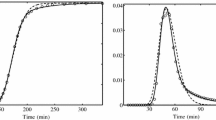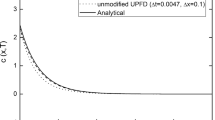Abstract
A number of contributions have been made during the last decades to model pure-diffusive transport problems by using the so-called hyperbolic diffusion equations. These equations are used for both mass and heat transport. The hyperbolic diffusion equations are obtained by substituting the classic constitutive equation (Fick’s and Fourier’s law, respectively), by a more general differential equation, due to Cattaneo (C R Acad Sci Ser I Math 247:431–433, 1958). In some applications the use of a parabolic model for diffusive processes is assumed to be accurate enough in spite of predicting an infinite speed of propagation (Cattaneo, C R Acad Sci Ser I Math 247:431–433, 1958). However, the use of a wave-like equation that predicts a finite velocity of propagation is necessary in many other calculations. The studies of heat or mass transport with finite velocity of propagation have been traditionally limited to pure-diffusive situations. However, the authors have recently proposed a generalization of Cattaneo’s law that can also be used in convective-diffusive problems (Gómez, Technical Report (in Spanish), University of A Coruña, 2003; Gómez et al., in An alternative formulation for the advective-diffusive transport problem. 7th Congress on computational methods in engineering. Lisbon, Portugal, 2004a; Gómez et al., in On the intrinsic instability of the advection–diffusion equation. Proc. of the 4th European congress on computational methods in applied sciences and engineering (CDROM). Jyväskylä, Finland, 2004b) (see also Christov and Jordan, Phys Rev Lett 94:4301–4304, 2005). This constitutive equation has been applied to engineering problems in the context of mass transport within an incompressible fluid (Gómez et al., Comput Methods Appl Mech Eng, doi:10.1016/j.cma.2006.09.016, 2006). In this paper we extend the model to compressible flow problems. A discontinuous Galerkin method is also proposed to numerically solve the equations. Finally, we present some examples to test out the performance of the numerical and the mathematical model.





Similar content being viewed by others
References
Compte A (1997) The generalized Cattaneo equation for the description of anomalous transport processes. J Phys A Math Gen 30:7277–7289
Özisik MN, Tzou DY (1994) On the wave theory in heat conduction. ASME J Heat Transf 116:526–535
Fick A (1855) Uber diffusion. Poggendorff’s Ann Phys Chem 94:59–86
Fourier JB (1822) Théorie analytique de la chaleur. Jacques Gabay
Jiang F, Sousa ACM (2006) SPH numerical modeling for ballistic-diffusive heat conduction. Numer Heat Transf 50:499-515
Vick B, Özisik MN (1983) Growth and decay of a thermal pulse predicted by the hyperbolic heat conduction equation. ASME J Heat Transf 105:902–907
Cattaneo MC (1958) Sur une forme de l’equation de la chaleur éliminant le paradoxe d’une propagation instantaneé. C R Acad Sci Ser I Math 247:431–433
Joseph DD, Preziosi L (1989) Heat waves. Rev Mod Phys 61:41–73
Joseph DD, Preziosi L (1990) Addendum to the paper “heat waves”. Rev Mod Phys 62:375–391
Duhamel P (2004) Application of a new finite integral transform method to the wave model of conduction. Int J Heat Mass Transf 47:573–588
Ali YM, Zhang LC (2005) Relativistic heat conduction. Int J Heat Mass Transf 48:2397–2406
Haji-Sheikh A, Minkowycz WJ, Sparrow EM (2002) Certain anomalies in the analysis of hyperbolic heat conduction. J Heat Transf 124:307–319
Jiang F, Sousa ACM (2005) Analytical solution for hyperbolic heat conduction in a hollow sphere. AIAA J Thermophys Heat Transf 19:595–598
Jiang F (2006) Solution and analysis of hyperbolic heat propagation in hollow spherical objects. Heat Mass Transf 42:1083–1091
Arora M (1996) Explicit characteristic-based high resolution algorithms for hyperbolic conservation laws with stiff source terms. PhD dissertation, University of Michigan
Carey GF, Tsai M (1982) Hyperbolic heat transfer with reflection. Numer Heat Transf 5:309–327
Wu W, Li X (2006) Application of the time discontinuous Galerkin finite element method to heat wave simulation. Int J Heat Mass Transf 49:1679–1684
Yang HQ (1992) Solution of two-dimensional hyperbolic heat conduction by high resolution numerical methods, AIAA-922937
Manzari MT, Manzari MT (1999) On numerical solution of hyperbolic heat equation. Commun Numer Methods Eng 15:853–866
Shen W, Han S (2003) A numerical solution of two-dimensional hyperbolic heat conduction with non-linear boundary conditions. Heat Mass Transf 39:499–507
Gómez H (2003) A new formulation for the advective-diffusive transport problem. Technical Report (in Spanish), University of A Coruña
Gómez H, Colominas I, Navarrina F, Casteleiro M (2004a) An alternative formulation for the advective-diffusive transport problem. In: Mota Soares CA, Batista AL, Bugeda G, Casteleiro M, Goicolea JM, Martins JAC, Pina CAB, Rodrigues HC (eds) 7th Congress on computational methods in engineering. Laboratório Nacional de Engenharia Civil, Lisboa (Portugal)
Gómez H, Colominas I, Navarrina F, Casteleiro M (2004b) On the intrinsic instability of the advection–diffusion equation. In: Neittaanmäki P, Rossi T, Korotov S, Oñate E, Périaux J, Knörzer D (eds) Proc. of the 4th European congress on computational methods in applied sciences and engineering (CDROM). ECCOMAS-European Community on Computational Methods in Applied Sciences, Jyväskylä (Finland)
Gómez H, Colominas I, Navarrina F, Casteleiro M (2006) A finite element formulation for a convection-diffusion equation based on Cattaneo’s law. Comput Methods Appl Mech Eng. doi:10.1016/j.cma.2006.09.016
Christov CI, Jordan PM (2005) Heat conduction paradox involving second-sound propagation in moving media. Phys Rev Lett 94:4301–4304
Courant R, Friedrichs KO (1999) Supersonic flow and shock waves. Springer, New York
Reed WH, Hill TR (1973) Triangular mesh methods for the neutron transport equation. Technical Report LA-UR-73-479, Los Alamos Scientific Laboratory
Cockburn B, Karniadakis GE, Shu C-W (eds) (1999) Discontinuous Galerkin methods. Theory, computation and applications. Springer, New York
Cockburn B, Shu C-W (1989) TVB Runge-Kutta local projection discontinuous Galerkin finite element method for scalar conservation laws II: general framework. Math Comput 52:411–435
Cockburn B, Lin S-Y, Shu C-W (1989) TVB Runge-Kutta local projection discontinuous Galerkin finite element method for conservation laws III: one-dimensional systems. J Comput Phys 84:90–113
Cockburn B, Shu C-W (1998) The Runge-Kutta discontinuous Galerkin finite element method for conservation laws V: multidimensional systems. J Comput Phys 141:199–224
Cockburn B, Shu C-W (2001) Runge-Kutta discontinuous Galerkin methods for convection dominated flows. J Sci Comput 16:173–261
Bassi F, Rebay S (1997) A high-order accurate discontinuous finite element method for the numerical solution of the compressible Navier-Stokes equations. J Comput Phys 131:267–279
Cockburn B, Shu C-W (1998) The local discontinuous Galerkin method for time-dependent convection-diffusion systems. SIAM J Numer Anal 35:2440–2463
Baumann CE, Oden JT (1999) A discontinuous hp finite element method for convection-diffusion problems. Comput Methods Appl Mech Eng 175:311–341
Baumann CE, Oden JT (1999) A discontinuous hp finite element method for the Euler and the Navier-Stokes equations. Int J Numer Methods Eng 31:79–95
Castillo P (2002) Performance of discontinuous Galerkin methods for elliptic PDEs. SIAM J Sci Comput 24:524–547
Castillo P, Cockburn B, Perugia I, Schötzau D (2000) An a priori error analysis of the local discontinuous Galerkin method for elliptic problems. SIAM J Numer Anal 38:1676–1706
Van Leer B (1982) Flux vector splitting for the Euler equations. Lect Notes Phys 170:507–512
Hänel D, Schwane R, Seider G (1987) On the accuracy of upwind schemes for the resolution of the Navier-Stokes equations, AIAA Paper, 87-1005
Bibb KL, Peraire J, Riley CJ (1997) Hypersonic flow computations on unstructured meshes, AIAA Paper, 97-0625
Gómez H, Colominas I, Navarrina F, Casteleiro M, A discontinuous Galerkin method for a hyperbolic model for convection-diffusion problems in CFD. Int J Numer Methods Eng (accepted)
Gómez H (2006) A hyperbolic formulation for convective-diffusive problems in CFD. PhD dissertation (in Spanish), University of A Coruña
Shu C-W, Osher S (1988) Efficient implementation of essentially non-oscillatory shock-capturing schemes. J Comput Phys 77:439–471
Sarrate J, Huerta A (2000) Efficient unstructured quadrilateral mesh generation. Int J Numer Methods Eng 49:1327–1350
Acknowledgments
H. Gómez gratefully acknowledges the support provided by Ministerio de Educación y Ciencia through the postdoctoral fellowships program. The authors were partially supported by Xunta de Galicia (grants # PGIDIT05PXIC118002PN and # PGDIT06TAM11801PR), Ministerio de Educación y Ciencia (grants # DPI2004-05156, # DPI2006-15275 and # DPI2007-61214) cofinanced with FEDER funds, Universidad de A Coruña and Fundación de la Ingeniería Civil de Galicia. This funding is gratefully acknowledged.
Author information
Authors and Affiliations
Corresponding author
Rights and permissions
About this article
Cite this article
Gómez, H., Colominas, I., Navarrina, F. et al. A mathematical model and a numerical model for hyperbolic mass transport in compressible flows. Heat Mass Transfer 45, 219–226 (2008). https://doi.org/10.1007/s00231-008-0418-0
Received:
Accepted:
Published:
Issue Date:
DOI: https://doi.org/10.1007/s00231-008-0418-0




